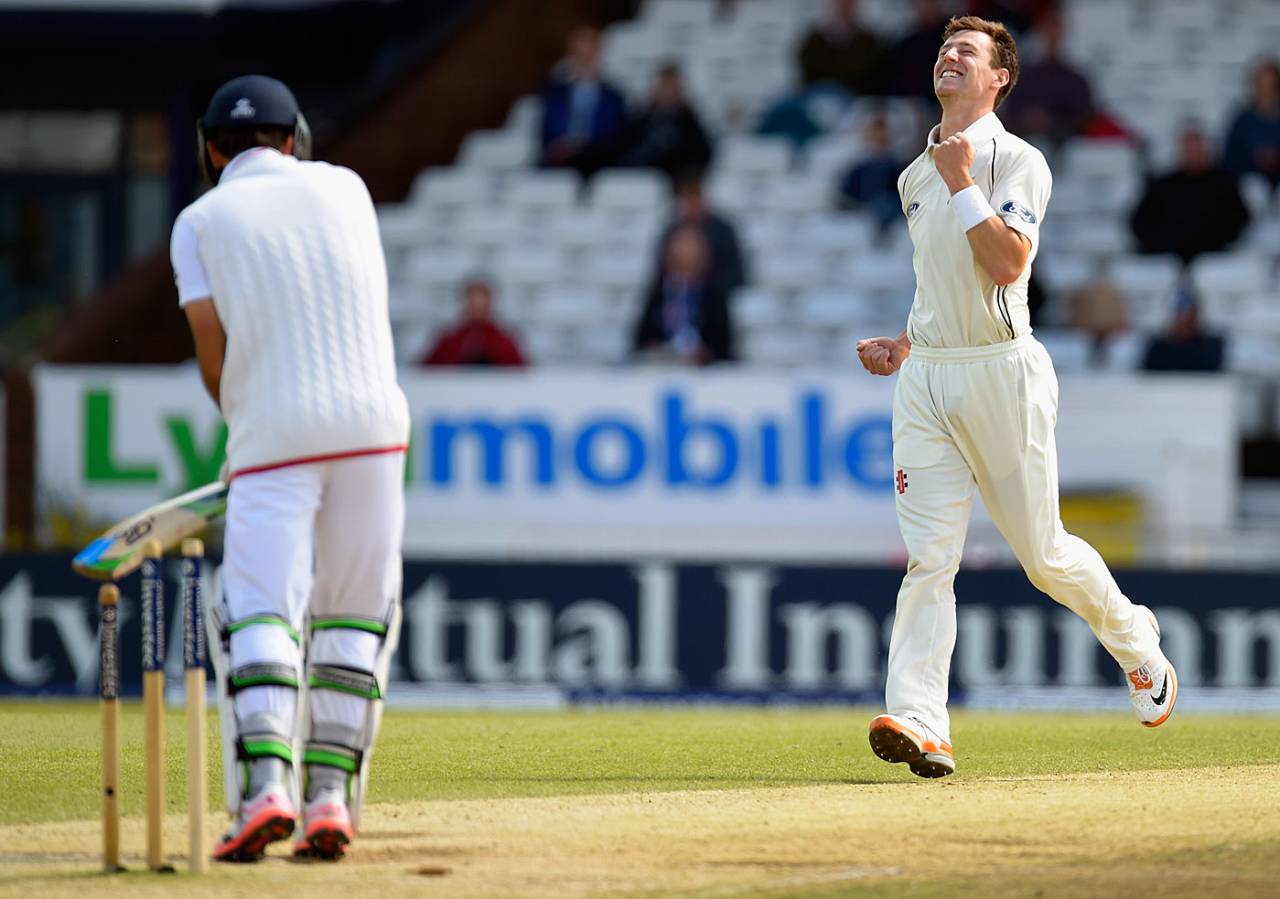Small yet significant contributions in wins, and costly five-fors
Also: the slowest to 1000 Test runs, and other trivia from the 2015 Headingley Test

Small is big: Matt Henry's 39 runs and two wickets played a satisfying part in the win at Headingley • Getty Images
It's obviously difficult to quantify this sort of thing exactly, but I asked ESPNcricinfo's ace number-cruncher Travis Basevi whether he could come up with a formula. He told me that, excluding extras and run-outs, the overall bowling average in all Tests is 31.43. That means that the smallest contribution to New Zealand's fine win at Headingley was by Ross Taylor (68 runs, no wickets), as Kane Williamson's contribution was 100.29 and Matt Henry's 101.86. And, Travis informs me, that is indeed the highest minimum contribution in Tests, beating Mushfiqur Rahim's 61 in Bangladesh's victory over Zimbabwe in Chittagong in 2014-15, and three instances of 59 (Mohammad Kaif for India v West Indies in St John's in 2006, Nayan Mongia for India v South Africa in Kanpur in 1996-97, and Michael Hussey for Australia v South Africa in Johannesburg in 2011-12). It's not a perfect formula - the presence of two wicketkeepers in the names mentioned reminds us there's no provision for catches - but, as Travis points out, "even if you change the value of a wicket to 20, or 40, New Zealand at Headingley are still significantly in front - so a most excellent spot."
As you suspected, James Anderson was the first player to require more than 100 Test matches to reach four figures in the runs column; he got there in his 143rd innings (another record) in his 104th match. Muttiah Muralitharan needed 95 matches (and 121 innings), while Waqar Younis got there in 86 (118 innings). Zaheer Khan reached 1000 in his 73rd Test (102 innings) and Dale Steyn in 70 (91). Curtly Ambrose needed 99 innings, but got there quicker in terms of matches (69). Just for the record, Don Bradman reached 1000 in just seven matches, although he needed 13 innings; Herbert Sutcliffe and Everton Weekes both got there in 12 innings, spread over nine matches. George Headley also got there in his ninth match (17th innings).

After the Headingley Test, James Anderson's batting average stood at 10.77: there's only one person with a worse average than that, given a minimum of 1,000 runs, and that's Waqar Younis of Pakistan - 1010 at 10.20. Next comes Muttiah Muralitharan (1261 at 11.77), Zaheer Khan (1231 at 11.95), and Curtly Ambrose (1439 at 12.40). For the full list, click here. Anderson is the 60th man - the 13th from England - to complete the Test double of 1000 runs and 100 wickets.
Those two instances of 350 at Headingley was the eighth time both sides had made the same score in the first innings of a Test. The highest total involved is 593, by West Indies (who lost only five wickets before declaring) and England in St John's in 1993-94, in the match in which Brian Lara scored 375. Australia (for seven wickets) and West Indies both started with 428 at Kingston in 1972-73, while in the previous Test chronologically New Zealand and Pakistan swapped 402s at Auckland. At Edgbaston in 1986 both England and India scored 390, while in St John's in 2002-03 both sides made 240 (Australia then made 417, and West Indies broke the Test record by overhauling that). In Kanpur in 1958-59 both West Indies and India started with 222, while the first instance was in Durban in 1909-10, when both England and South Africa made 199 in their first innings.
Stuart Broad's peculiar figures in the first innings at Headingley - 17.1-0-109-5 - meant he went for 6.34 runs an over, which is the highest rate for any five-for in Test history. The only other one completed while conceding more than a run a ball was by Dale Steyn (13.1-1-82-5; that's 6.25 an over) for South Africa against Sri Lanka in Colombo in 2006. Jeff Thomson had figures of 13-1-77-6 (5.92 per over) against West Indies at Bridgetown in 1977-78. For the full list, click here. The most expensive ten-for, in terms of runs per over, was by the Australian legspinner Arthur Mailey, whose match figures against England in Adelaide in 1920-21 were 61.3-6-302-10 (4.91 an over). Next up is another Aussie, offspinner Jason Krejza, who marked his debut - against India in Nagpur in 2008-09 - with figures of 74.5-4-358-12, at 4.78 per over. For that list, click here.
The youngest player to represent South Africa in a Test was the unorthodox left-arm spinner Paul Adams, who was aged 18 years 340 days when he made his debut against England in Port Elizabeth on Boxing Day in 1995. He broke a record that had stood for over a century: South Africa's previous-youngest debutant was the Transvaal batsman Arthur Ochse, in his country's inaugural Test, against England in Port Elizabeth, a match that started on March 12, 1889, the day after his 19th birthday. The oldest debutant among South Africa's 321 Test cricketers to date was another left-arm spinner, Omar Henry, who was 40 years 295 days old against India in Durban in 1992-93. Geoff Chubb, in England in 1951, was the only other South African to win his first Test cap when over 40 years of age.
Steven Lynch is the editor of the Wisden Guide to International Cricket 2014. Ask Steven is now on Facebook